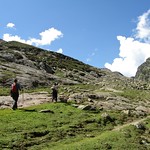


Every trek in Kashmir is a journey through a landscape that feels dreamlike and untouched.
Known as the “Paradise on Earth,” Kashmir offers some of the most scenic and soul-stirring treks in the Indian Himalayas. Trek in Kashmir and explore lush valleys, alpine lakes, and snow-capped peaks that create postcard-perfect views at every turn.
With peaceful trails and breathtaking landscapes, a trek in Kashmir offers an unforgettable Himalayan adventure.
Trekking in Kashmir is not just about physical endurance—it’s about immersing yourself in beauty, serenity, and solitude. Here are just a few reasons why Kashmir is a dream destination for trekkers:
Unmatched Scenery: Snow-capped mountains, lush green valleys, glacial lakes, and blooming meadows—Kashmir’s terrain changes every few kilometers.
Less Crowded Trails: Compared to Ladakh or Himachal treks, many routes in Kashmir remain peaceful and untouched.
Adventure for All Levels: From easy walks to challenging multi-day treks, there’s something for everyone.
Duration: 7 days
Difficulty: Moderate to Difficult
Best Time: July to September
Altitude: 13,750 ft (4,200 m)
The kashmir great lakes trek is the crown jewel of Kashmir trekking, taking you through an alpine wonderland of seven pristine lakes—each more breathtaking than the last. Starting from Sonamarg and ending in Naranag, the trail takes you past lakes like Vishansar, Gadsar, Satsar, and Gangbal, each reflecting the snow-laden peaks above.
The meadows are carpeted with wildflowers, and the changing hues of the lakes depending on light and weather are mesmerizing.
Duration: 6–7 days
Difficulty: Moderate
Best Time: July to September
Altitude: 13,200 ft (4,023 m)
A slightly easier alternative to the Kashmir Great Lakes, this trek focuses on the twin alpine lakes—Tarsar and Marsar, which are considered sacred and offer surreal beauty.
Camping beside the lake under a starlit sky is an unforgettable highlight. This trek begins from Aru Village, near Pahalgam, and combines adventure with tranquility.
Duration: 3–4 days
Difficulty: Moderate
Best Time: June to September
Altitude: 11,500 ft (3,500 m)
For those short on time but still eager for alpine scenery, the Gangbal Lake Trek is ideal. Starting from Naranag, this short trek takes you to the twin lakes of Gangbal and Nundkol, nestled at the base of Mount Harmukh—a revered peak in Kashmiri tradition.
Duration: 4–5 days
Difficulty: Moderate
Best Time: June to September
Altitude: 12,000 ft (3,658 m)
This lesser-known trek leads you to the Kolahoi Glacier, the largest in Kashmir. Starting from the charming Aru village, the trail takes you through alpine forests, rushing streams, and meadows grazed by Gujjar shepherds.
The views of Mount Kolahoi (known as the Matterhorn of Kashmir) and the surrounding peaks are awe-inspiring.
The ideal time for trekking in Kashmir is from June to mid-October, depending on the trek.
June–July: Snow begins to melt, and meadows turn green.
August–September: Lakes are fully thawed, flowers are in full bloom, and weather is perfect.
October: Cooler temperatures, autumn foliage, and fewer crowds.
Winter treks are limited due to heavy snowfall, but snowshoeing and skiing options are available in places like Gulmarg.
Good-quality trekking shoes
Warm clothes (layers, even in summer)
Waterproof jacket and pants
Sleeping bag (if not provided by tour operator)
Trekking poles
UV-protection sunglasses and sunscreen
Water bottles and purification tablets
Basic medicines and first-aid kit
Torch or headlamp
Camera for those unreal views!
Though some treks are beginner-friendly, most require moderate fitness due to elevation and multi-day walking. Start a fitness routine 4–6 weeks prior to your trek, focusing on:
Cardio: Running, cycling, swimming
Strength: Leg and core exercises
Practice hikes or walks with a loaded backpack
Acclimatization is less of an issue compared to Ladakh, but take it slow the first day, especially above 3,000 meters.
Always trek with a local guide or group—many trails are remote and poorly marked.
Respect nature: Carry back all trash, avoid picking flowers, and use eco-friendly toiletries.
Support locals: Stay in homestays when possible and buy from local vendors.
Follow permit regulations: Some areas require registration with local authorities.
